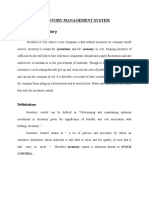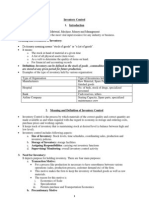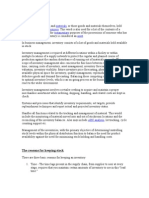Part 6 Inventory
Uploaded by
ተክለወይኒ ገብረሚካኤልPart 6 Inventory
Uploaded by
ተክለወይኒ ገብረሚካኤል1|Page
Chemical Engineering Department
Production and Project Management
1. Inventory
Inventory generally refers to the materials in stock. It is also called the idle resource of an enterprise. Inventories
represent those items which are either stocked for sale or they are in the process of manufacturing or they are in the
form of materials, which are yet to be utilized. The interval between receiving the purchased parts and transforming them
into final products varies from industries to industries depending upon the cycle time of manufacture. It is, therefore,
necessary to hold inventories of various kinds to act as a buffer between supply and demand for efficient operation of the
system. Thus, an effective control on inventory is a must for smooth and efficient running of the production cycle with least
interruptions1.
The inventory may also be defined as the physical stock of good, units or economic resources that are stored or reserved
for smooth, efficient and effective functioning of business. Many companies have wide-ranging inventories, consisting of
many small items such as paper pads, pencils, and paper clips, and fewer big items such as trucks, machines, and
computers. A particular company's inventory is related to the business in which it is engaged. A tennis shop has an
inventory of tennis rackets, shoes, and balls. A television manufacturer has parts, subassemblies, and finished TV sets in its
inventory. A theater has an inventory of seats, a restaurant has an inventory of tables and chairs, and a public accounting
firm has an inventory of accountants.
Without inventories customer would have to wait until their orders were filled from a source or were produced. In general,
customer will not like to wait for long period of time. Another reason for maintaining inventory is the price fluctuation of
some raw material, (may be seasonal), it would be profitable for a buyer to procure a sufficient quantity of raw material at
lower price and use it whenever needed. Some researchers also argue that maintaining inventories on display attracts
more customers resulting increase in sale and profits2.
Set by: Tekleweyni G. MSc. in Material Science and Engineering
2|Page
1.1. Types of Inventory
The inventory is divided into two categories; direct inventory and indirect inventory.
Direct inventory
It is one that is used for manufacturing the product. It is further sub-divided into following groups.
1. Raw material inventories
2. Work-in-process inventories
3. Finished – goods inventory
4. Spare parts inventory
Indirect inventory
The indirect inventory does not play any role in finished goods product but it is required for manufacturing. Thus, indirect
inventory acts as catalyst which only speeds up / down the reaction. The indirect inventory is classified as follows:
1. Fluctuation inventory: This acts as equilibrium between sales and production. The reserve stock that is kept to maintain
fluctuations in the demand and lead – time, affecting the production of items is called fluctuation inventory.
2. Anticipation inventory: This is programmed in advance for the seasonal large sales, slack season, a plant shut down
period etc.
3. Transportation inventories: The existence of transportation inventories is mainly due to movement of materials from one
place to another.
4. Decoupling Inventories: These inventories are maintained for meeting out the demands during the decoupling period of
manufacturing or purchasing.
1.2. Reasons for Keeping Inventories
1. To stabilize production: The demand for an item fluctuates because of the number of factors, e.g., seasonality, production
schedule etc. The inventories (raw materials and components) should be made available to the production as per the
demand failing which results in stock out and the production stoppage takes place for want of materials. Hence, the
inventory is kept to take care of this fluctuation so that the production is smooth.
2. To take advantage of price discounts: Usually the manufacturers offer discount for bulk buying and to gain this price
advantage the materials are bought in bulk even though it is not required immediately. Thus, inventory is maintained to gain
economy in purchasing.
Set by: Tekleweyni G. MSc. in Material Science and Engineering
3|Page
3. To meet the demand during the replenishment period: The lead time for procurement of materials depends upon many
factors like location of the source, demand supply condition, etc. So inventory is maintained to meet the demand during the
procurement (replenishment) period.
4. To prevent loss of orders (sales): In this competitive scenario, one has to meet the delivery schedules at 100 per cent
service level, means they cannot afford to miss the delivery schedule which may result in loss of sales. To avoid the
organizations have to maintain inventory.
5. To keep pace with changing market conditions: The organizations have to anticipate the changing market sentiments and
they have to stock materials in anticipation of non-availability of materials or sudden increase in prices.
6. Sometimes the organizations have to stock materials due to other reasons like suppliers minimum quantity condition,
seasonal availability of materials or sudden increase in prices.
1.3. Inventory Control
Inventory control is a planned approach of determining what to order, when to order and how much to order and how much
to stock so that costs associated with buying and storing are optimal without interrupting production and sales. Inventory
control basically deals with two problems: (i) When should an order be placed? (Order level), and (ii) How much should be
ordered? (Order quantity).
The scientific inventory control system strikes the balance between the loss due to non-availability of an item and cost of
carrying the stock of an item. Scientific inventory control aims at maintaining optimum level of stock of goods required by
the company at minimum cost to the company.
1.4. Techniques of Inventory Control
In any organization, depending on the type of business, inventory is maintained. When the number of items in inventory is
large and then large amount of money is needed to create such inventory, it becomes the concern of the management to
have a proper control over its ordering, procurement, maintenance and consumption. The control can be for order quality
and order frequency. The different techniques of inventory control are: (1) ABC analysis, (2) HML analysis, (3) VED analysis,
(4) FSN analysis, (5) SDE analysis, (6) GOLF analysis and (7) SOS analysis. The most widely used method of inventory control
is known as ABC analysis. In this technique, the total inventory is categorized into three sub-heads and then proper
exercise is exercised for each sub-heads.
Set by: Tekleweyni G. MSc. in Material Science and Engineering
4|Page
1. ABC analysis: In this analysis, the classification of existing inventory is based on annual consumption and the annual value
of the items.
Once ABC classification has been achieved, the policy control can be formulated as follows:
A-Item: Very tight control, the items being of high value. The control need be exercised at higher level of authority.
B-Item: Moderate control, the items being of moderate value. The control need be exercised at middle level of
authority.
C-Item: The items being of low value, the control can be exercised at gross root level of authority, i.e., by respective
user department managers.
2. HML analysis: In this analysis, the classification of existing inventory is based on unit price of the items. They are
classified as high price, medium price and low cost items.
3. VED analysis: In this analysis, the classification of existing inventory is based on criticality of the items. They are
classified as vital, essential and desirable items. It is mainly used in spare parts inventory.
4. FSN analysis: In this analysis, the classification of existing inventory is based consumption of the items. They are
classified as fast moving, slow moving and non-moving items.
5. SDE analysis: In this analysis, the classification of existing inventory is based on the items.
6. GOLF analysis: In this analysis, the classification of existing inventory is based sources of the items. They are classified
as Government supply, ordinarily available, local availability and foreign source of supply items.
7. SOS analysis: In this analysis, the classification of existing inventory is based nature of supply of items. They are
classified as seasonal and off-seasonal items1.
1.5. Costs associated with inventory
1. Purchase (or production) Cost: The value of an item is its unit purchasing (production) cost. This cost becomes significant
when availing the price discounts.
2. Capital Cost: The amount invested in an item, (capital cost) is an amount of capital not available for other purchases. If
the money were invested somewhere else, a return on the investment is expected. A charge to inventory expenses is made
to account for this un-received return. The amount of the charge reflects the percentage return expected from other
investment.
Set by: Tekleweyni G. MSc. in Material Science and Engineering
5|Page
3. Ordering Cost: It is also known by the name procurement cost or replenishment cost or acquisition cost. Cost of
ordering is the amount of money expended to get an item into inventory. This takes into account all the costs incurred from
calling the quotations to the point at which the items are taken to stock.
There are two types of costs—Fixed costs and variable costs.
Fixed costs do not depend on the number of orders whereas variable costs change with respect to the number of orders
placed. The salaries and wages of permanent employees involved in purchase function and control of inventory, purchasing,
incoming inspection, accounting for purchase orders constitute the major part of the fixed costs. The cost of placing an
order varies from one organization to another.
They are generally classified under the following heads:
(i) Purchasing: The clerical and administrative cost associated with the purchasing, the cost of requisitioning material,
placing the order, follow-up, receiving and evaluating quotations.
(ii) Inspection: The cost of checking material after they are received by the supplier for quantity and quality and maintaining
records of the receipts.
(iii) Accounting: The cost of checking supply against each order, making payments and maintaining records of purchases.
(iv) Transportation costs
4. Inventory Carrying Costs (Holding Costs): These are the costs associated with holding a given level of inventory on hand
and this cost vary in direct proportion to the amount of holding and period of holding the stock in stores. The holding costs
include;
(i) Storage costs (rent, heating, lighting, etc.).
(ii) Handling costs: Costs associated with moving the items such as cost of labor, equipment for handling.
(iii) Depreciation, taxes and insurance.
(iv) Costs on record keeping.
(v) Product deterioration and obsolescence.
(vi) Spoilage, breakage, pilferage and loss due to perishable nature.
5. Shortage Cost: When there is a demand for the product and the item needed is not in stock, then we incur a shortage
cost or cost associated with stock out. The shortage costs include:
(i) Backorder costs.
(ii) Loss of future sales.
(iii) Loss of customer goodwill.
Set by: Tekleweyni G. MSc. in Material Science and Engineering
6|Page
(iv) Extra cost associated with urgent, small quantity ordering costs.
(v) Loss of profit contribution by lost sales revenue.
The unsatisfied demand can be satisfied at a later stage (by means of back orders) or unfulfilled demand is lost completely
(no back ordering, the shortage costs become proportional to only the shortage quantity) 3.
REFERENCE
1. Kumar SA, Suresh N. Production and Operations Management. 2nd ed.; 2008.
2. Gor RM. INDUSTRIAL STATISTICS AND OPERATIONAL MANAGEMENT.
3. TELSANG MT. Industrial Engineering And Production Management.; 2015.
Set by: Tekleweyni G. MSc. in Material Science and Engineering
You might also like
- Management and Cost Accounting 11th Edition Mike Tayles - Ebook PDF All Chapter Instant Download90% (10)Management and Cost Accounting 11th Edition Mike Tayles - Ebook PDF All Chapter Instant Download41 pages
- Study of Inventory Management in Manufacturing Industry: Aashna Sharma, Vivek AryaNo ratings yetStudy of Inventory Management in Manufacturing Industry: Aashna Sharma, Vivek Arya10 pages
- Manage: Offering For Sale and Components That Make Up The Product."No ratings yetManage: Offering For Sale and Components That Make Up The Product."6 pages
- CHAPTER - 7 Inventory Mgmt. - FormattedNo ratings yetCHAPTER - 7 Inventory Mgmt. - Formatted29 pages
- Inventory Management of Big Bazaar (Thane)100% (3)Inventory Management of Big Bazaar (Thane)59 pages
- TOPIC ONE INVENTORY UPDATED NOTES 2024 (1)No ratings yetTOPIC ONE INVENTORY UPDATED NOTES 2024 (1)17 pages
- Chapter 1: Inrtoduction 1.1 Introduction of Inventory Management100% (1)Chapter 1: Inrtoduction 1.1 Introduction of Inventory Management61 pages
- Inventory Management of Big Bazaar (Aniket Patil)100% (2)Inventory Management of Big Bazaar (Aniket Patil)38 pages
- Inventory Control: Are Stored at Any Given Period For Future ProductionNo ratings yetInventory Control: Are Stored at Any Given Period For Future Production8 pages
- To Meet Anticipated Customer Demand. To Smooth Production RequirementsNo ratings yetTo Meet Anticipated Customer Demand. To Smooth Production Requirements11 pages
- Inventory Management: K, J, Karthika, Final Year P.G Scholar Departmnet of R&B, GAVC, Tripunithura67% (3)Inventory Management: K, J, Karthika, Final Year P.G Scholar Departmnet of R&B, GAVC, Tripunithura70 pages
- Introduction of Inventory Management: If Inventories Are Too LargeNo ratings yetIntroduction of Inventory Management: If Inventories Are Too Large56 pages
- PSM 206 Lesson 1 Inventory Control NotesNo ratings yetPSM 206 Lesson 1 Inventory Control Notes9 pages
- Inventory Means: Goods Materials Business Testamentary AssetNo ratings yetInventory Means: Goods Materials Business Testamentary Asset5 pages
- Module 4 - Materials Management (2nd Sem, C2 AY 2021-2022) FinalNo ratings yetModule 4 - Materials Management (2nd Sem, C2 AY 2021-2022) Final46 pages
- Inventory Management and Control: Dependent and Independent Demand ItemsNo ratings yetInventory Management and Control: Dependent and Independent Demand Items8 pages
- Purchasing, Inventory, and Cash Disbursements: Common Frauds and Internal ControlsFrom EverandPurchasing, Inventory, and Cash Disbursements: Common Frauds and Internal Controls4.5/5 (3)
- Military Supply Chain Management: From Deployment to Victory, Mastering the Logistics DanceFrom EverandMilitary Supply Chain Management: From Deployment to Victory, Mastering the Logistics DanceNo ratings yet
- Chapter 9: Inventories: Additional Valuation Issues: Intermediate Accounting, 11th Ed. Kieso, Weygandt, and WarfieldNo ratings yetChapter 9: Inventories: Additional Valuation Issues: Intermediate Accounting, 11th Ed. Kieso, Weygandt, and Warfield23 pages
- Paper 16 Chapters 1 To 5 With Addition MatterNo ratings yetPaper 16 Chapters 1 To 5 With Addition Matter372 pages
- Paper 5 Cost and Management Accounting PDF50% (2)Paper 5 Cost and Management Accounting PDF685 pages
- Kaizen Costing: A Catalyst For Change and Continuous Cost ImprovementNo ratings yetKaizen Costing: A Catalyst For Change and Continuous Cost Improvement16 pages
- Classroom Code: 3A/: A. B. Smaller Than The Operating Income Reported Under The Absorption Costing ConceptNo ratings yetClassroom Code: 3A/: A. B. Smaller Than The Operating Income Reported Under The Absorption Costing Concept4 pages
- Factors Affecting Facility Location Decision in Operations ManagementNo ratings yetFactors Affecting Facility Location Decision in Operations Management10 pages
- SITHKOP015 Standard Recipe Card (SRC) Template (2) 3100% (1)SITHKOP015 Standard Recipe Card (SRC) Template (2) 32 pages
- R - KSBT Activity Type Price On Cost CenterNo ratings yetR - KSBT Activity Type Price On Cost Center7 pages
- Management and Cost Accounting 11th Edition Mike Tayles - Ebook PDF All Chapter Instant DownloadManagement and Cost Accounting 11th Edition Mike Tayles - Ebook PDF All Chapter Instant Download
- Study of Inventory Management in Manufacturing Industry: Aashna Sharma, Vivek AryaStudy of Inventory Management in Manufacturing Industry: Aashna Sharma, Vivek Arya
- Manage: Offering For Sale and Components That Make Up The Product."Manage: Offering For Sale and Components That Make Up The Product."
- Chapter 1: Inrtoduction 1.1 Introduction of Inventory ManagementChapter 1: Inrtoduction 1.1 Introduction of Inventory Management
- Inventory Control: Are Stored at Any Given Period For Future ProductionInventory Control: Are Stored at Any Given Period For Future Production
- To Meet Anticipated Customer Demand. To Smooth Production RequirementsTo Meet Anticipated Customer Demand. To Smooth Production Requirements
- Inventory Management: K, J, Karthika, Final Year P.G Scholar Departmnet of R&B, GAVC, TripunithuraInventory Management: K, J, Karthika, Final Year P.G Scholar Departmnet of R&B, GAVC, Tripunithura
- Introduction of Inventory Management: If Inventories Are Too LargeIntroduction of Inventory Management: If Inventories Are Too Large
- Inventory Means: Goods Materials Business Testamentary AssetInventory Means: Goods Materials Business Testamentary Asset
- Module 4 - Materials Management (2nd Sem, C2 AY 2021-2022) FinalModule 4 - Materials Management (2nd Sem, C2 AY 2021-2022) Final
- Inventory Management and Control: Dependent and Independent Demand ItemsInventory Management and Control: Dependent and Independent Demand Items
- Purchasing, Inventory, and Cash Disbursements: Common Frauds and Internal ControlsFrom EverandPurchasing, Inventory, and Cash Disbursements: Common Frauds and Internal Controls
- Learn Our Efficient Inventory Management TechniquesFrom EverandLearn Our Efficient Inventory Management Techniques
- Military Supply Chain Management: From Deployment to Victory, Mastering the Logistics DanceFrom EverandMilitary Supply Chain Management: From Deployment to Victory, Mastering the Logistics Dance
- Chapter 9: Inventories: Additional Valuation Issues: Intermediate Accounting, 11th Ed. Kieso, Weygandt, and WarfieldChapter 9: Inventories: Additional Valuation Issues: Intermediate Accounting, 11th Ed. Kieso, Weygandt, and Warfield
- Kaizen Costing: A Catalyst For Change and Continuous Cost ImprovementKaizen Costing: A Catalyst For Change and Continuous Cost Improvement
- Classroom Code: 3A/: A. B. Smaller Than The Operating Income Reported Under The Absorption Costing ConceptClassroom Code: 3A/: A. B. Smaller Than The Operating Income Reported Under The Absorption Costing Concept
- Factors Affecting Facility Location Decision in Operations ManagementFactors Affecting Facility Location Decision in Operations Management
- SITHKOP015 Standard Recipe Card (SRC) Template (2) 3SITHKOP015 Standard Recipe Card (SRC) Template (2) 3

























































































